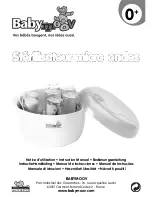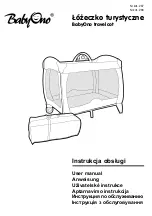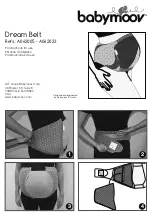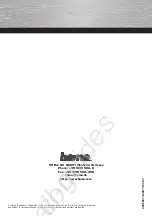
10
DRESSING OF STROPPING/POLISHING DISKS – STAGE 2
The Model 315S is equipped with a built-in accessory to manually clean/dress the
stropping/polishing disks in Stage 2. In the event these disks become glazed with grease, food
or sharpening debris, they can be cleaned and reshaped by actuating the manual lever on the
rear of the sharpener. This lever is located within a recess as shown in Figure 11 on the lower
left corner as you face the rear of the Sharpener. To actuate the cleaning/dressing tool, make
sure the power is on and simply press the small lever in the recess to the right, hold about
3-4 seconds and then press to the left and repeat for 3-4 seconds. When the lever is moved in
one direction, the dressing tool cleans and reshapes the active surface of one stropping/polish-
ing disk. By next moving in the opposite direction you clean the other disk.
Use this clean/dress accessory only if the Stage 2 white disks are seriously darkened and when
Stage 2 no longer appears to be stropping/polishing well. Using this tool removes material from the
surface of the Stage 2 disks and hence, if used excessively, it will unnecessarily remove too much
of the abrasive surface – wearing the disks out prematurely. If that should occur, factory replace-
ment of the disks will become necessary. If you clean your knives regulary before sharpening you
should need to clean or dress the Stage 2 disks only about once a year or less frequently.
SUGGESTIONS
1. Always clean all food, fat and foreign materials from knife before sharpening or resharpening.
If soiled, carefully wash the blade before sharpening.
2. Use only light downward pressure when sharpening – just enough to establish secure
contact with the abrasive disk.
3. EUROPEAN/AMERICAN BLADES, Fig. 9c
While most of the Euro/American knives (shown on the right)
have a thicker cross-section designed for heavier work, the
range of blade thickness in these familiar blades is great and
certain of these knives, such as the conventional paring, fillet
and utility blades, have a relatively thin cross-section well
suited to their intended application. Euro/American blades
are universally double beveled (sharpened on both sides of
the blade.)
Thickness
(approx.
0.5m m )
double faceted
Figure 10. Cross-section of a typical factory traditional
Asian knife edge,
m agnified 50x (right-handed).
Back
Factory
Bevel A
Front
edge
facet,
15°
M icrofacet
15°
approx.
.002 inch
Figure 11. Cleaning the polishing disks (see text).
Each facet
about 20°
Factory
Bevel A
Figure 9c.






























